*My posts may contain affiliate links, which means I may receive a small commission, at no cost to you, if you make a purchase through a link! Thank you for supporting my website!*
Last updated on March 15th, 2024 at 12:30 pm
Wondering if kitchen islands are supposed to be the same height as the other counters in your kitchen? Well, look no further because I have your answer!
Kitchen islands are typically the same height as the other counters (36 inches), but they can be raised to bar height (42 inches) to add taller seating and workspace. Both heights are comfortable standing and sitting heights for adults.
Now that we’ve got the basics covered, let’s break into the details further so you can choose which counter height is best for your kitchen.
Let’s dive in!
Quick Navigation: Kitchen Island Bar Height Vs Counter Height
- What Height Should A Kitchen Island Be?
- Are Counter Or Bar Height Kitchen Islands Better?
- Other FAQs About Kitchen Island Counter Heights
- Final Thoughts
What Height Should A Kitchen Island Be?
Kitchen islands should be counter-height (36 inches from the ground to the top of the counter) or bar-height (42 inches from the ground to the top of the counter). Both heights are considered standard for kitchen islands.
The most popular kitchen island height you will find in homes is the counter height.
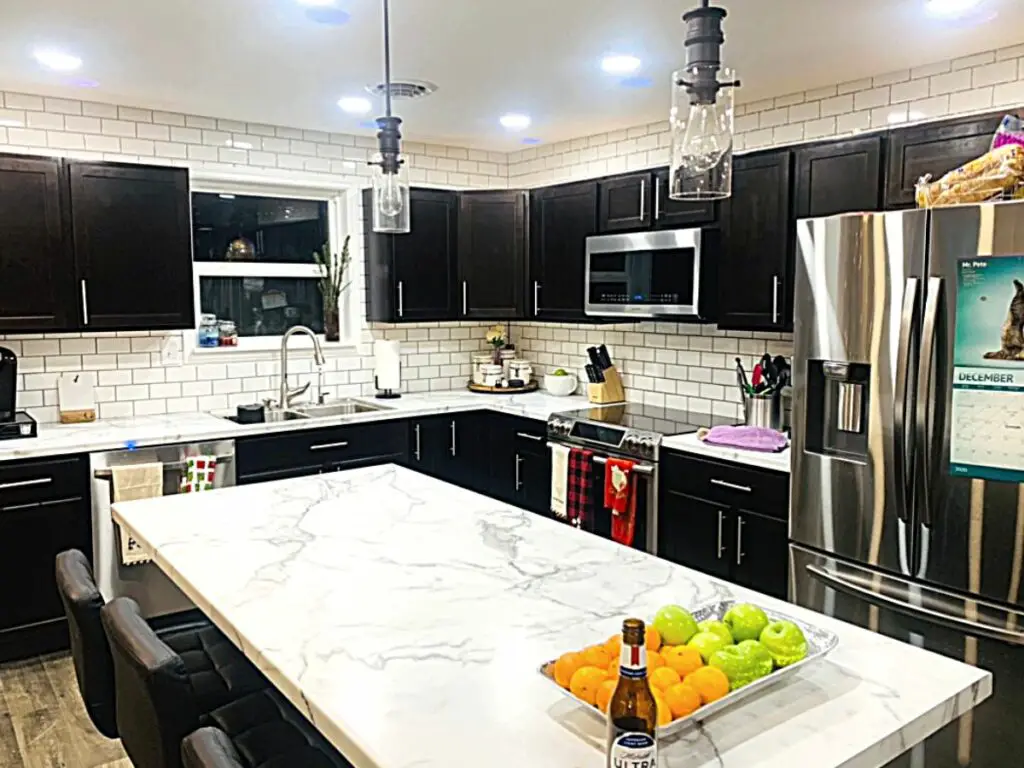
Are Counter Or Bar Height Kitchen Islands Better?
In general, the average person likes the counter-height kitchen island the best. However, there are some pros to the bar-height kitchen island as well.
| Counter-Height Kitchen Island Benefits | Bar-Height Kitchen Island Benefits |
|---|---|
| Cabinets Are Already Built At The Standard Height | Kitchen Islands With Sinks Or Appliance In Them Can Have A Backsplash To Contain/Hide The Mess |
| The Workspace Is The Entire Island | The Differing Counter Heights Creates Contrast On The Island |
| The View In The Room Is More Open | Makes The Kitchen Feel Like A Separate Room |
| It’s Cheaper To Build A Counter Height Island | More Comfortable To Use If You Or A Family Member lly Tall |
| More Comfortable To Use If You Or A Family Member Are An Average Height |
Counter-Height Kitchen Island Benefits
There are several benefits to counter-height kitchen islands.
Benefit One: Cabinets Are Already Built At The Standard Height
The first benefit of counter-height islands is the fact that cabinets are already built at this standard height.
Kitchen islands are typically made out of base cabinets, and the standard height of these base cabinets is 34.5 inches tall. Once a countertop is added, the most common kitchen island height is 36 inches tall.
Since cabinets are already built at this standard dimension, you don’t have to do or buy anything extra to achieve the counter-height. That makes this island height the easiest to install.
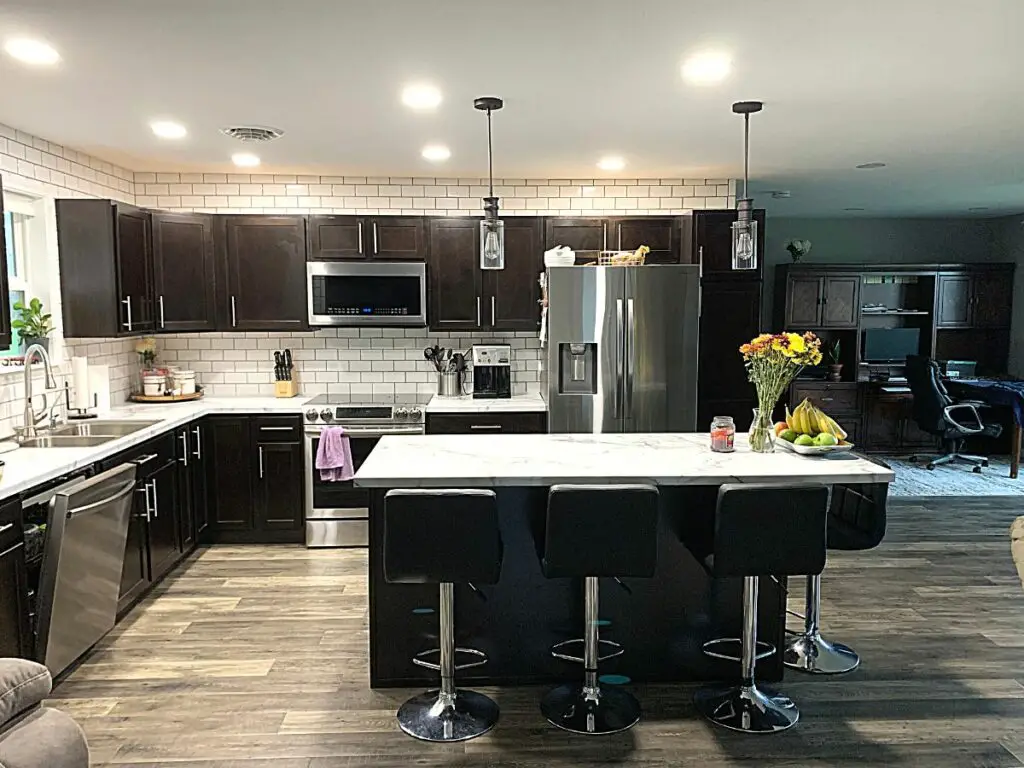
Benefit Two: The Workspace Is The Entire Island
The next benefit of counter-height islands is the fact that the entire island can be your workspace.
Usually, counter-height islands have one large, flat countertop that spans the entire distance of the island. It might be broken up with a sink or an appliance, but for the most part, the entire countertop is a flat workspace.
Bar-height islands, on the other hand, tend to be broken up into two different countertops – one part is usually counter height and usually houses the sink or the stove while the other part is bar height and is flat for eating.
Bar-height kitchen islands can have the entire countertop be the same height as well, however, that requires the entire island to be built up to the taller height instead of only part of it. That typically is more time and labor-intensive, so it costs more money.

Benefit Three: The View In The Room Is More Open
The next benefit of counter-height islands is that it makes the room feel more open.
Since the counter is the same height as the counters in the rest of the kitchen, your vision doesn’t get chopped up, so the entire room feels more open.
Bar-height sits taller than the rest of the kitchen, so it makes the kitchen feel blocked off (or like a separate room). If your kitchen is open-concept, then you likely won’t notice this.
But if your kitchen is on the smaller side, then the added height of a bar-height island can make the room feel crowded.
Benefit Four: It’s Cheaper To Build A Counter Height Island
The next benefit of counter-height islands is it is cheaper to build.
As I mentioned above, counter-height kitchen islands are simply several standard base cabinets screwed together with a single countertop attached.
Bar-height islands, on the other hand, often require additional countertops and additional leg supports for the overhang that’s raised up. These additional items cost more than the basic items needed for a counter-height island.

Benefit Five: More Comfortable To Use If You Or A Family Member Are An Average Height
The final benefit of counter-height islands is that this height is more comfortable to use if you and most of your family is an average height.
The standard kitchen island base cabinet is 34.5 inches tall for a reason. It is the height that is most comfortable for the majority of people in the world to stand next to and use. So if your family is of average height (6 ft or less), then this is likely the best height kitchen island for you.

Bar-Height Kitchen Island Benefits
Now that we’ve discussed the benefits of counter-height kitchen islands, let’s discuss the benefits of bar-height kitchen islands.
Benefit One: Kitchen Islands With Sinks Or Appliance In Them Can Have A Backsplash To Contain/Hide The Mess
The first benefit of bar-height islands is that they can create a backsplash for a sink or appliance installed on the island.
Usually, bar-height islands are broken up into one half being counter-height and containing the sink or stove and the other half being bar-height for the seating. Since there is a 6-inch height difference, that creates a mini wall that hides the sink or stove.
One of the biggest downsides to having a sink in the kitchen island is that you’ll probably be eating next to dirty dishes at some point.
On a bar-height counter, since the sink usually sits lower/is separate from the eating area on the bar, it can hide the dirty dishes and give you some space from the potential smell.
Also, that mini wall can have a backsplash installed on it so any splashes for a sink or stove will be contained to only one side of the island.
If you really want a sink or stove located on your island, you might consider making the seating half of the island bar-height to help hide the mess that comes with sinks and stoves. (I also have an article explaining the pros and cons of having the sink on the island or under the window to help you decide which is best for your family’s needs.)

Benefit Two: The Differing Counter Heights Creates Contrast On The Island
The next benefit of bar-height islands is the differing counter heights create contrast.
If you feel like your kitchen is looking bland and cookie-cutter, then an easy way to make it appear more custom-built is to raise one side of the island to bar-height.
Since counter-height is the norm, installing a bar-height island can be one way to make your kitchen look more unique.
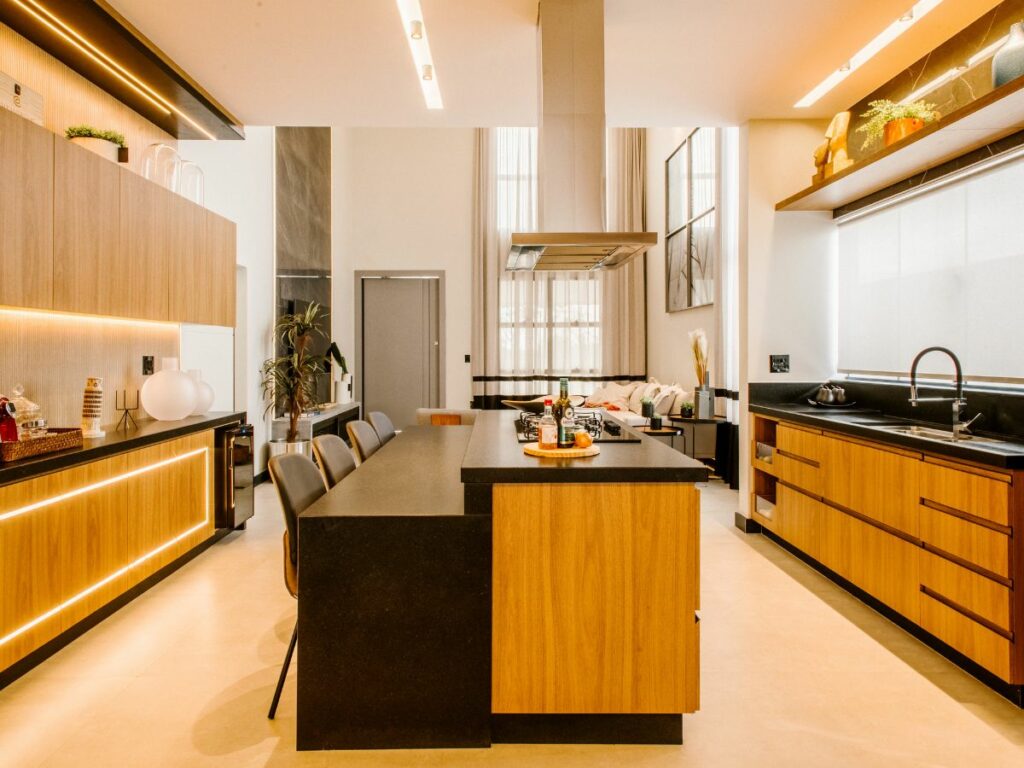
Benefit Three: Makes The Kitchen Feel Like A Separate Room
The next benefit of bar-height islands is it makes the kitchen feel a little bit more like a separate room.
If you want your home to feel less “open concept”, then raising the kitchen island to the bar-height helps to separate the room a little more. It won’t be a huge view blocker because the bar side is only 6 inches taller than the other side, but it will block a little bit more than the counter height island.
As we mentioned above, if your island houses a sink, then hiding the clutter that always comes with kitchen sinks is usually a move you will appreciate you took.
However, if your kitchen is smaller or already not “open-concept”, this is a fast way to make your small kitchen feel even smaller since the higher countertop will cut off some of your vision of the room.
The best way to decide is to have someone hold a giant piece of cardboard up or put other items that are the height you want in the place where you think you want the island to go to help you see if the height and sizing are what you truly want.
I am a visual person, so any time I can lay out my thoughts in the actual location before I purchase something, I usually like the outcome better.

Benefit Four: More Comfortable To Use If You Or A Family Member Are Really Tall
The final benefit of bar-height islands is that they can be more comfortable to use if most of your family is over 6 ft tall.
My brother is 6′ 3″ and he does have to slouch a little bit to use my kitchen island. Though, me, my husband, and the rest of my family who is 6 foot or under do not have this problem.
So if you have a much taller family, then the raised height might be nicer for everyone to use (at least on the half of the island that is bar-height). Just an additional thought!

Other FAQs About Kitchen Island Counter Heights
Here are some other frequently asked questions about kitchen islands to help you choose the best height for your kitchen!
Can A Kitchen Island Be Lower Than The Other Countertops?
The standard counter height of 36 inches is the lowest you want a kitchen island to be because this is a comfortable height for the average adult to stand and eat at. Anything lower than this will require most adults to crouch while standing and using the island.
In addition, standard barstools are made for counter-height or bar-height islands, not custom-height islands so shopping will be easier.
Can A Kitchen Island Be Higher Than The Other Countertops?
Kitchen islands can be set at a bar height of 42 inches which is taller than the standard counter height. Anything higher than this will make it much more challenging to shop for barstools that are standard heights.
Plus, counter- and bar-height kitchen islands are set at comfortable heights for the average adult to stand and eat at. Anything much higher and it will be difficult for the average person to comfortably use the island.
What Is The Standard Stool Height For A Counter-Height Kitchen Island?
The standard stool height for a counter-height kitchen island is a 24-inch seat height for a 36-inch countertop height. I recommend having 10-12 inches between the top of the seat and the bottom of the counter for plenty of leg-room.
What Is The Standard Stool Height For A Bar-Height Kitchen Island?
The standard stool height for a bar-height kitchen island is a 30-inch seat height for a 42-inch countertop height. I recommend having 10-12 inches between the top of the seat and the bottom of the counter for plenty of leg-room.
What Is The Standard Overhang For A Kitchen Island Counter?
The standard overhang for a kitchen island counter is 8-12 inches without additional leg support. Any countertop overhang longer than this will need extra legs to support it. I recommend a countertop overhang of at least 12 inches if you can fit it in your kitchen because it is more comfortable to sit at.
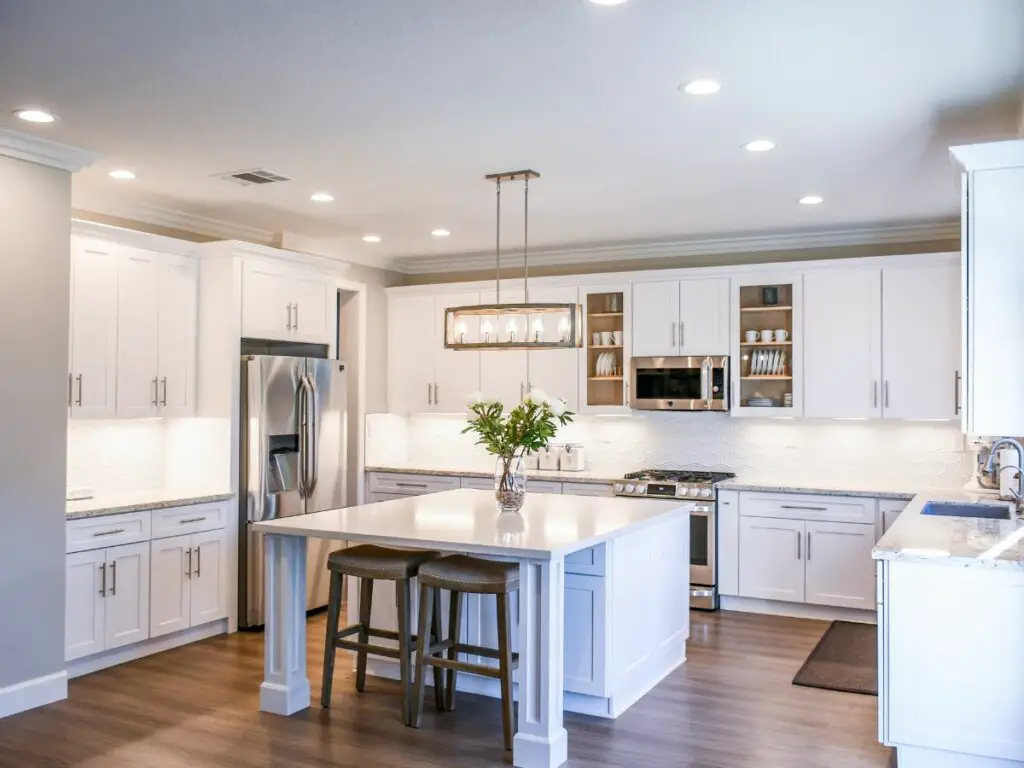
Final Thoughts On Kitchen Island Counter Heights
There you have it!
You really can’t go wrong with either height! But if you are still unsure, then I recommend choosing the counter-height kitchen island.
Most people will be expecting this height, and you’ll likely enjoy this height the best while standing and sitting at an island this height.
Hopefully, this guide helped you narrow down which kitchen island height is best for you.
Catch you in my next post!
The Best Kitchen Tools & Products I’ve Used
Ravinte Cabinet Handle Installation Template (For Doors & Drawers)
This is my all-time favorite handle installation template because it has two templates (one for drawers and one for doors) with multiple pull sizes & knob placements! These templates make installing cabinet handles a breeze because you always know your handles will be installed in the same spot on all of your drawers and doors. The kit also comes with a drill bit so you can guarantee you’re using the correct size. I used this template on my entire kitchen and both bathrooms to cut the installation time in half. You can find this hardware template here on Amazon.


Franklin Brass 5-1/16 Inch (128mm) Center Bar Pull (Stainless Steel)
If you want to immediately modernize your kitchen island, then these cabinet pulls are a must. They are heavy-duty feeling, durable, easy to install, and are a large size for a great price. We put these pulls on all of our kitchen and island doors and drawers along with our bathroom doors and drawers. You can find these gorgeous cabinet pulls here on Amazon.
P.S. Use the hardware installation template I mentioned above to install these new pulls in record time!
If you’ve been curious about how we are decorating our 1950s Ranch, you should check out our “Shop Our Home” page. You can find products that we’ve personally bought to decorate our home.
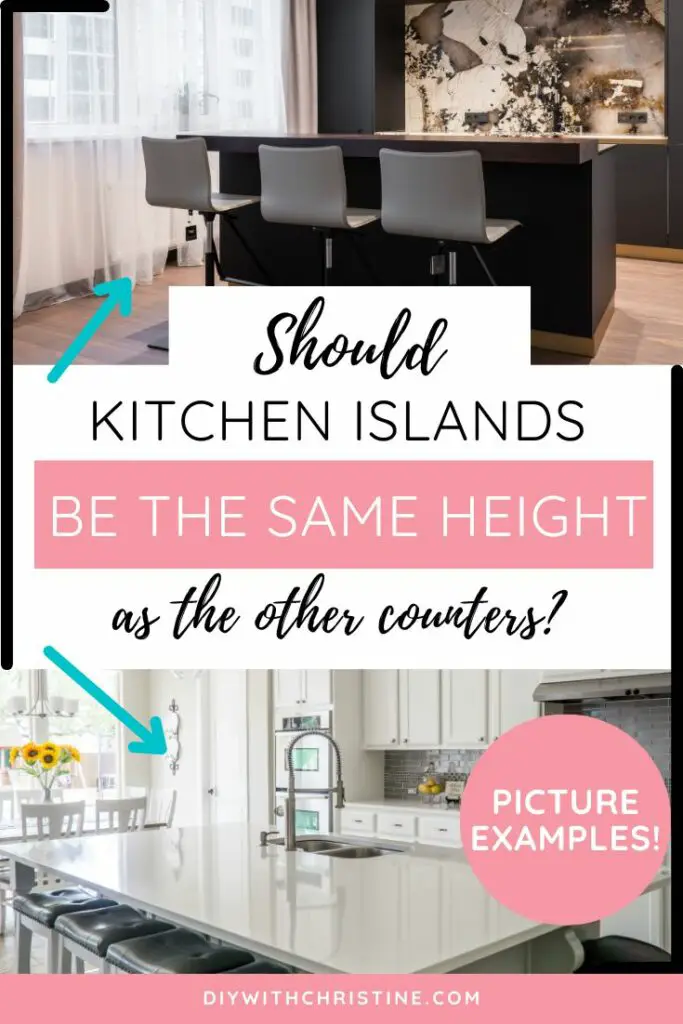

By Christine
Christine is a blogger and DIYer who tackles home renovation and decorating projects alongside her husband, Adam, for their personal residence and rental properties. Although she successfully tackles large renovation projects to avoid expensive contractor fees and bring her vision to life now, her path to success was not easy.
Go here to read her story, “From a Clueless First-Time Homebuyer To A Confident DIYer Creating Her Dream Home One Project At A Time“.
Popular Posts
DIY With Christine is a participant in the Amazon Services LLC Associates Program, an affiliate advertising program designed to provide a means for sites to earn advertising fees by advertising and linking to Amazon.com.





